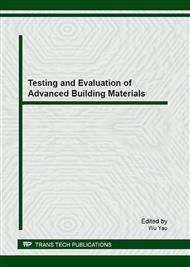p.1
p.5
p.10
p.14
p.19
p.25
p.30
p.35
The Application of Freezing-Melting Hysteresis in Hardened White Cement Paste
Abstract:
In this paper, the freezing-melting hysteresis was first obtained in two mesoporous molecular sieves with similar pore size to analyze the reason lead to the different results in nuclear magnetic resonance cryoporometry (NMR-C) experiment between them. Then the hardened white cement paste was explored by the same method. The primary results shows that the freezing branch can offer more details to the pore size distribution (PSD) obtained from the melting branch, which will probably improve the accuracy of PSD.
Info:
Periodical:
Pages:
10-13
Citation:
Online since:
January 2013
Authors:
Price:
Сopyright:
© 2013 Trans Tech Publications Ltd. All Rights Reserved
Share:
Citation:


